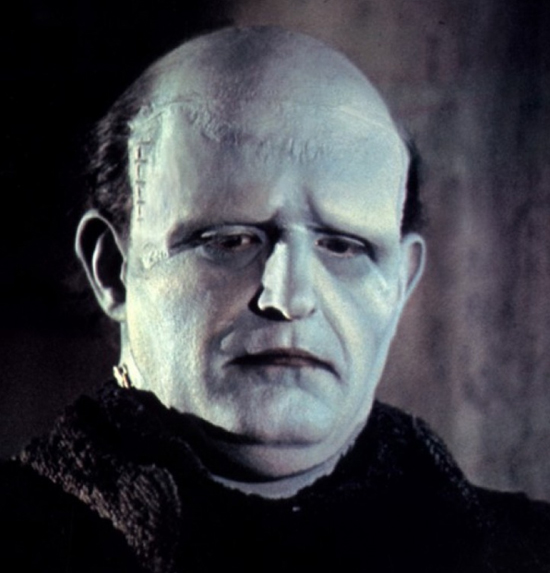The Monster appears! Yet another image from the blockbusting 1826 Paris run of Le Monstre et le magicien, again showing The Monster confronting its maker.
Béraud and Merle’s Le Monstre borrowed heavily from Richard Brinsley Peake’s Presumption, or The Fate of Frankenstein of 1823 — they even hired the original play’s Monster, actor T.P.Cooke. The Monster’s first appearance, as evidenced by the numerous illustrations it inspired, was the highlight of both plays. In a blast of smoke, lit by colored lights, The Monster bursts out of the laboratory. Frankenstein — Zametti, in the French version — pulls a sword. The Monster grabs it away and snaps it in two. In the original London play, The Monster then ran to a large window and leaped to freedom. In the French version, The Monster breaks the sword, throws it down and vanishes on the spot, dropping out of sight by means of a trap door. Cooke was familiar with the perilous device, having used one repeatedly to extraordinary effect as Polidori’s Lord Ruthven, The Vampire, in 1820. Cooke’s trap door, which came to be known as a “vampire trap”, used rubber doors and sandbags as counterweight, innovating on an old stage trick.
In a case of reverse influence, the French Le Monstre et le magicien would, in turn, transform Presumption when author Peake adopted Le Monstre’s stirring conclusion aboard a storm-tossed schooner, replacing the original avalanche ending. Both plays would influence new adaptations while still competing against each other for years to come. T.P.Cooke, crossing effortlessly from one play to the other, would, in time, rack up 365 performances as The Monster. Back in 1826, his Parisian sojourn would prove to be quite an adventure…

Upon his arrival, Cooke was stricken with gout, a painful affliction he blamed on the acidity of French wines. Laid up at his hotel, his foot wrapped in flannel, Cooke was unable to attend rehearsals but he rallied quickly and, relying on his familiarity with the part, he was able to make his June 10 premiere. Le Monstre was a phenomenal success, with police called out to handle the crush of sell-out crowds. On July 15, the Théâtre de la Porte Saint-Martin touted its triumph and spoofed its competitors with a vaudeville revue called Les Filets de Vulcain, ou le lendemain d’un succès (Vulcan’s Nets, or The Day After a Success). Cooke participated, speaking heavily accented French and sans makeup, in a sketch called Le Monstre.
Cooke was the toast of Paris yet, having vanquished the gout, another incident threatened his continued participation in the season's hit play...
In August 1867, an unsigned article in the “Parisian Sketches” section of The People’s Magazine, An Illustrated Miscellany For All Classes, published in London by The Society for Promoting Christian Knowledge — whose ministrations apparently did not extend to them foreigners — related an anecdote about “the well-known and highly respected Mr. T.P.Cooke” having played The Monster at the Théâtre de la Porte Saint-Martin, “about as ugly a building as can be imagined”. According to the article, “a misunderstanding arose between (Mr. Cooke) and the manager, in consequence of some unfair advantage the latter wished to take.” The problem went unresolved until Cooke was forced to action. One morning, he sent word that he would not be appearing onstage that evening, whereupon the manager had Cooke picked up by gendarmes and marched to the theater “almost as a prisoner”. Cooke remained adamant and, ultimately “fearing a disturbance among the audience”, the manager gave way and the performance went on as planned. The incident, according to the chauvinistic People’s Magazine, was “a circumstance… which not only showed the despotic power the French police can exercise in theatrical affairs, but brought to light the determined character of our countryman as well.”
A final controversy of sorts has to do with the likely-never-to-be-resolved question of The Monster’s exact color. In The Recollections and Reflections of J.R.Planché (London, 1872), the playwright of The Vampire visited his friend Cooke in Paris, noting, “his success was so great that “monstre bleu”, the color he painted himself, became the fashion of the day in Paris.”
Otherwise, in Sinnett’s Picture of Paris, published in London, 1845, the author’s description of the Théâtre de la Porte Saint-Martin singles out Le Monstre, writing, “In the year 1826… Mr. T.P.Cooke was received in the most flattering manner, and became quite the fashion of the day. His performance of the Monster in Frankenstein for eighty consecutive nights saved the theatre from bankruptcy, replenished its treasury, and for several weeks everything in Paris was pale green à la Monstre.”
Monstre vert or Monstre bleu? Either way, T.P.Cooke’s Parisian adventure was a colorful affair.
The Théâtre de la Porte Saint-Martin website.
The National Library of France Digitial Library site, Gallica.
Related:
The Monster of La Porte Saint-Martin
The Frankenstein of 1826, in Color
The First Monster: T.P.Cooke
Mary Shelley Meets Frankenstein




















